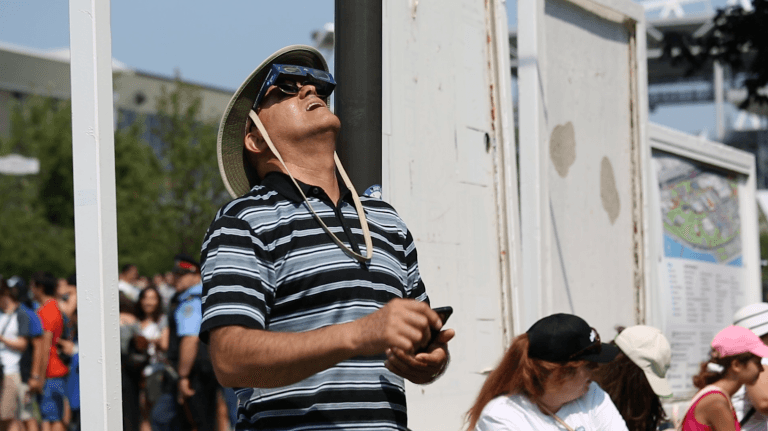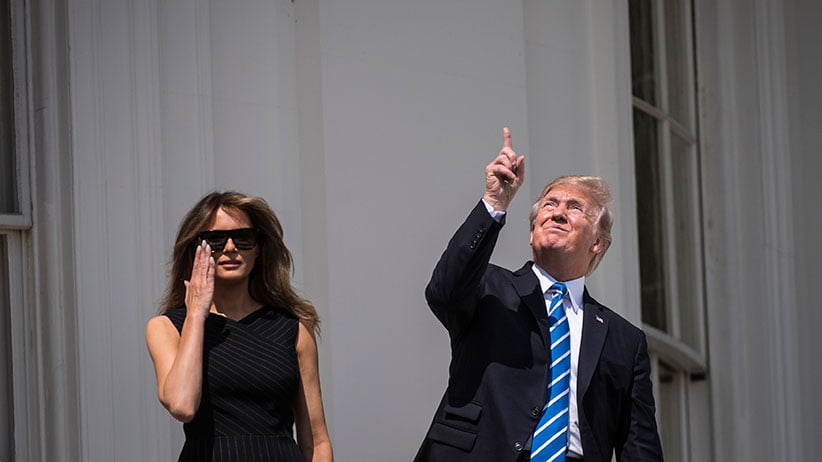Peeking at the eclipse has me seeing spots. Now what?
Optometrists were deluged with calls from Canadians who just couldn’t stop themselves. Lucky for them, it’s hard to look at the sun.

Share

Despite repeated warnings for weeks leading up to Monday’s eclipse, scores of people felt compelled to take unprotected glimpses at the spectacle—eye safety be damned. The U.S. president snuck a peek, at least one of your colleagues likely did, and maybe you glanced up once or twice, too. “I tried looking at it for a split second and saw spots for 20 minutes,” one friend told me in a cautionary text. Meanwhile, Google searches for “my eyes hurt,” “eye pain” and “sun damage eyes” all spiked around peak eclipse time.
Optometrists across the country were likewise busy answering similar queries on Tuesday. Dr. Jerry Nolfi, an optometrist at Toronto Eye Care clinic, says his staff took close to 30 calls from patients concerned about solar damage to their eyes. “Most of what we’ve seen so far has been inquiry about headaches, light sensitivity or brief after-image effects [the dim, floating shape sometimes seen after looking at a camera’s flash],” says Nolfi. “I haven’t seen any patients who have suffered any thermal damage to the retina. We did a lot of education, and hand-holding more than anything.”
Dr. Pavan Avinashi of Hollyburn Eye Clinic in North Vancouver had a similar day of answering phone calls and easing anxieties. He heard from more than a dozen patients concerned about sun damage, most of whom he examined, just to be safe. “Everyone I saw, their vision looked fine,” says Avinashi. “They weren’t showing any acute damage to their retina, but they’re all coming back in two weeks for something called optical coherence tomography testing, which is an infrared, CT-scan-like imaging of the retina to show there’s no sustained damage.”
For those willing to eschew expert advice in the name of curiosity, black spots and glare is probably the most unusual thing they saw on Monday. For most, the symptoms would have dissipated within minutes or a couple of hours. Others may have experienced something called solar keratitis, Avinashi explains, a temporary burn on the front of the eye, similar to a sunburn on the skin, which goes away within a day or two.
To do serious, long-term damage, you had to be looking at the sun for an extended period of time—a minute or more—says Dr. Ralph Chou, a retired optometrist who’s also the president of the Toronto branch of the Royal Astronomical Society of Canada. The sheer discomfort of staring at the sun for that long is typically a sufficient deterrent. But for those willing and able to power through the pain, the consequences can be devastating.
One potential effect, says Chou, is injury to the fovea, the part of the retina at the centre of your visual field where there’s the highest concentration of cones, or daytime photoreceptors. Those receptors are responsible for processing fine detail and colour vision. When the fovea is exposed to too much light—say, from prolonged staring at a partial eclipse—the photoreceptors are subjected to what Chou describes as a “photochemical attack”: oxygen buildup inside the cell to create “very, very corrosive chemicals,” he says. “If you look long enough, that photochemistry will lead to damage to the internal structures of the photoreceptor, and after a latent period of about 12 hours, the photoreceptor stops working.” Someone with this photochemical injury might wake up the next day with blurred vision or a blind spot in the centre of their visual field. The symptoms can take months to go away.
In a second scenario, patients experience nearly identical symptoms; the difference is they’re permanent. That’s because rather than—or in addition to—experiencing corrosion in the photoreceptors, the sun exposure burns a hole in a layer of cells in the retina. That layer, the pigmented epithelium, is normally responsible for trapping excess light to regulate the image quality you perceive. But if there’s too much light energy flooding into this area, that energy turns into heat, which generates steam and burns the pigmented epithelium. “We mean literally cooked from the inside,” says Chou.
The damage is impossible to reverse. But of the dozen-plus eye care professionals Maclean’s heard from (including some connected to online networks that update their colleagues on rare ocular injuries), none had seen or heard from patients with symptoms of photochemical or thermal eye injuries—also known as solar retinopathy. One did see a patient who lost three metres of vision in one eye, meaning she went from 20/20 to 20/30 vision. But that symptom alone is an unlikely indicator of long-term damage to the retina.
“My conclusion is the overwhelming amount of information available in the press … has probably prevented a lot potential eyesight damage,” one ophthalmologist explained in an email. At the same time, they say the publicity may have heightened the public’s anxieties around sun exposure, explaining the high number of alarmed calls from patients who had no serious symptoms. Dr. Somya Dixit, an Ottawa-based optometrist, saw two young patients Tuesday, neither of whom had any signs of sun damage. “They were just freaked out by what they had read, and their parents convinced them to get a checkup,” she says. “They were fine.”
That said, anyone showing symptoms should get an eye exam. “If someone knows they did look directly at the sun with their naked eye,” says Dr. Avinashi, “if they’re having visual blurring, headaches, shadowing, blind spots, they should definitely get that checked out.”

